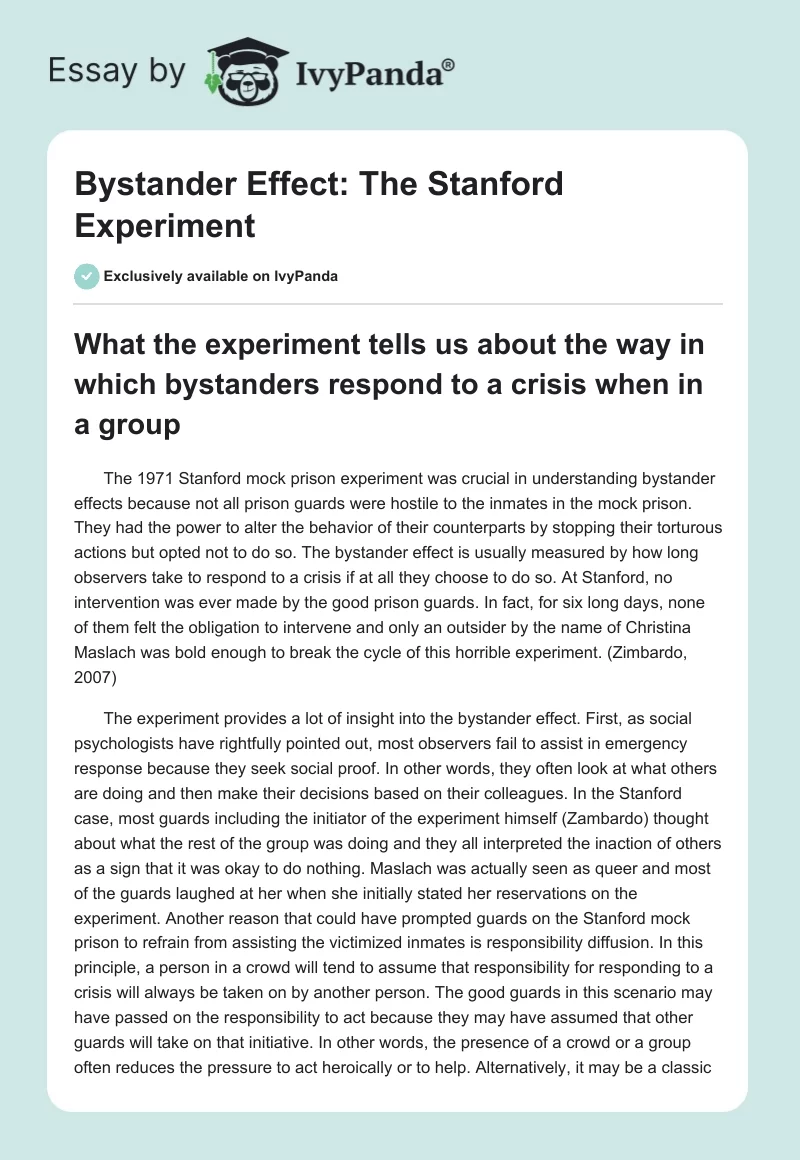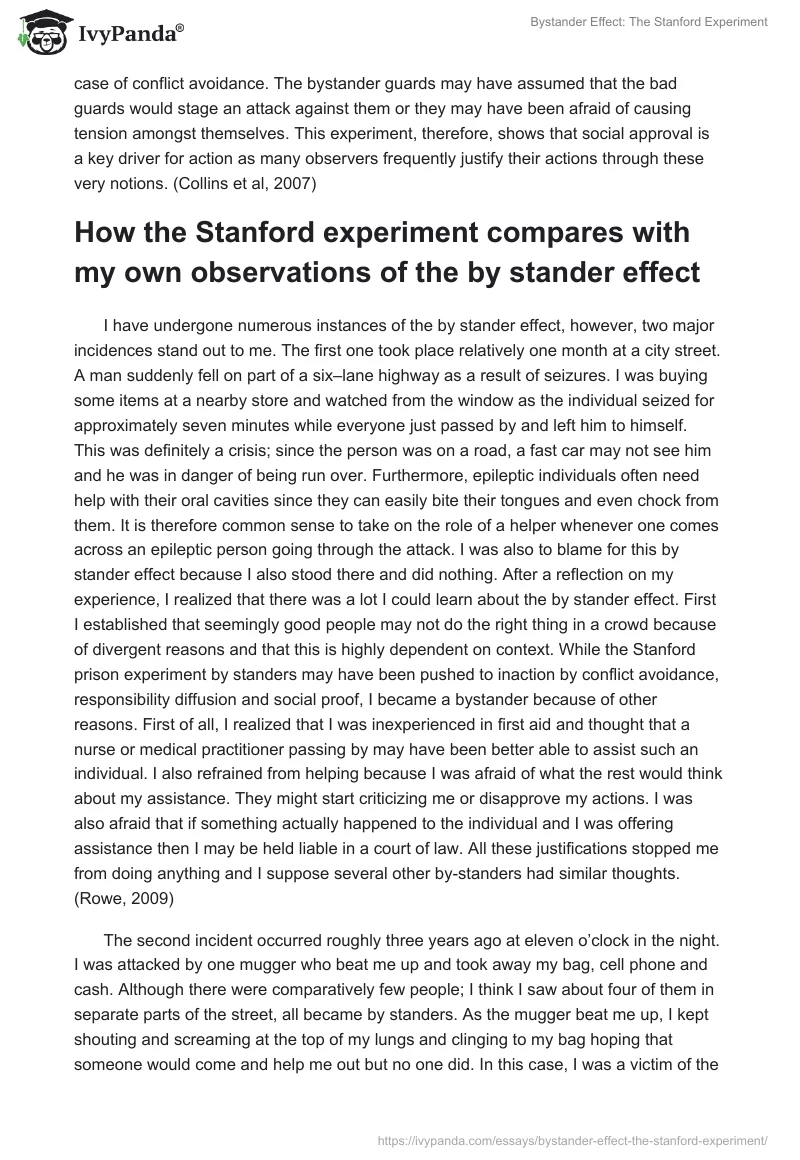What the experiment tells us about the way in which bystanders respond to a crisis when in a group
The 1971 Stanford mock prison experiment was crucial in understanding bystander effects because not all prison guards were hostile to the inmates in the mock prison. They had the power to alter the behavior of their counterparts by stopping their torturous actions but opted not to do so. The bystander effect is usually measured by how long observers take to respond to a crisis if at all they choose to do so. At Stanford, no intervention was ever made by the good prison guards. In fact, for six long days, none of them felt the obligation to intervene and only an outsider by the name of Christina Maslach was bold enough to break the cycle of this horrible experiment. (Zimbardo, 2007)
The experiment provides a lot of insight into the bystander effect. First, as social psychologists have rightfully pointed out, most observers fail to assist in emergency response because they seek social proof. In other words, they often look at what others are doing and then make their decisions based on their colleagues. In the Stanford case, most guards including the initiator of the experiment himself (Zambardo) thought about what the rest of the group was doing and they all interpreted the inaction of others as a sign that it was okay to do nothing. Maslach was actually seen as queer and most of the guards laughed at her when she initially stated her reservations on the experiment. Another reason that could have prompted guards on the Stanford mock prison to refrain from assisting the victimized inmates is responsibility diffusion. In this principle, a person in a crowd will tend to assume that responsibility for responding to a crisis will always be taken on by another person. The good guards in this scenario may have passed on the responsibility to act because they may have assumed that other guards will take on that initiative. In other words, the presence of a crowd or a group often reduces the pressure to act heroically or to help. Alternatively, it may be a classic case of conflict avoidance. The bystander guards may have assumed that the bad guards would stage an attack against them or they may have been afraid of causing tension amongst themselves. This experiment, therefore, shows that social approval is a key driver for action as many observers frequently justify their actions through these very notions. (Collins et al, 2007)
How the Stanford experiment compares with my own observations of the by stander effect
I have undergone numerous instances of the by stander effect, however, two major incidences stand out to me. The first one took place relatively one month at a city street. A man suddenly fell on part of a six–lane highway as a result of seizures. I was buying some items at a nearby store and watched from the window as the individual seized for approximately seven minutes while everyone just passed by and left him to himself. This was definitely a crisis; since the person was on a road, a fast car may not see him and he was in danger of being run over. Furthermore, epileptic individuals often need help with their oral cavities since they can easily bite their tongues and even chock from them. It is therefore common sense to take on the role of a helper whenever one comes across an epileptic person going through the attack. I was also to blame for this by stander effect because I also stood there and did nothing. After a reflection on my experience, I realized that there was a lot I could learn about the by stander effect. First I established that seemingly good people may not do the right thing in a crowd because of divergent reasons and that this is highly dependent on context. While the Stanford prison experiment by standers may have been pushed to inaction by conflict avoidance, responsibility diffusion and social proof, I became a bystander because of other reasons. First of all, I realized that I was inexperienced in first aid and thought that a nurse or medical practitioner passing by may have been better able to assist such an individual. I also refrained from helping because I was afraid of what the rest would think about my assistance. They might start criticizing me or disapprove my actions. I was also afraid that if something actually happened to the individual and I was offering assistance then I may be held liable in a court of law. All these justifications stopped me from doing anything and I suppose several other by-standers had similar thoughts. (Rowe, 2009)
The second incident occurred roughly three years ago at eleven o’clock in the night. I was attacked by one mugger who beat me up and took away my bag, cell phone and cash. Although there were comparatively few people; I think I saw about four of them in separate parts of the street, all became by standers. As the mugger beat me up, I kept shouting and screaming at the top of my lungs and clinging to my bag hoping that someone would come and help me out but no one did. In this case, I was a victim of the bystander effect and felt quite bitter at the passers by. They were only courageous enough to approach me after establishing that the mugger had already fled. Upon analyzing my situation I realized that these people may have become by standers because they were afraid of the mugger and subsequent victimization by him. They may also have been affected by the responsibility diffusion principle since other bystanders were also present. Furthermore, de-individuation may have come into play since none of them knew me from before and therefore did not feel the need to assist. (Mc Courtney, 2005) This incident was quite similar to the Stanford experiment because both scenarios involved some element of social proof and responsibility diffusion.
Summary
The Stanford mock-prison experiment has very important insights on why people would choose not to act even when they know that an emergency is taking place. This experiment compares a slight extent to my own experiences with the effect because certain reasons were common to the experiment and my won experiences such as social proof and responsibility diffusion while others were unique to context such as fear of victimization and criminal liability. Since I have been a victim and a bystander, I can relate to the reasons behind inaction.
References
Collins, A., Levine, M. & Manning, R. (2007). Kitty Genovese murder. American psychologist journal, 62(4), 555
Rowe, M. (2009). By stander effect. MA: MIT press
McCartney, T. (2005). ‘Help me’ but no one did. The Guardian
Zimbardo, P. (2007). The Lucifer effect- Understanding how good people turn evil. NY: Random house


